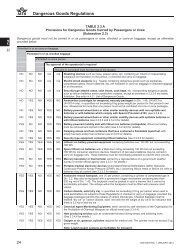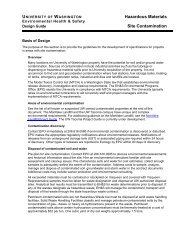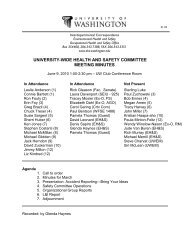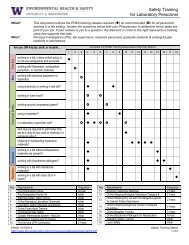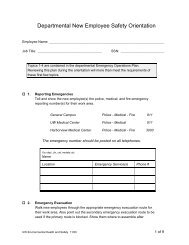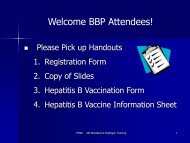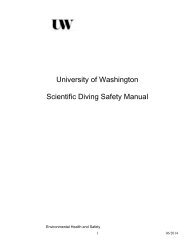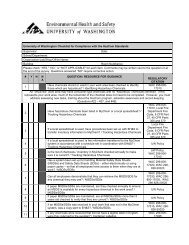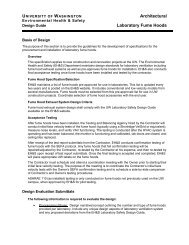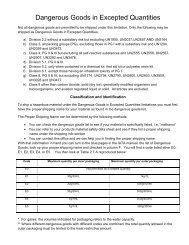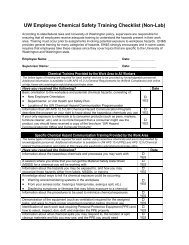Biosafety Training PowerPoint - Environmental Health and Safety ...
Biosafety Training PowerPoint - Environmental Health and Safety ...
Biosafety Training PowerPoint - Environmental Health and Safety ...
Create successful ePaper yourself
Turn your PDF publications into a flip-book with our unique Google optimized e-Paper software.
University <strong>Biosafety</strong> Officer<br />
Research <strong>and</strong> Biological <strong>Safety</strong> Office<br />
<strong>Environmental</strong> <strong>Health</strong> <strong>and</strong> <strong>Safety</strong> Department<br />
Phone: 206.221.7770<br />
Email: rbso@u.washington.edu
To ensure potentially biohazardous material is<br />
h<strong>and</strong>led safely from start to finish<br />
1) Minimize Risk to lab Personnel <strong>and</strong> the Environment<br />
• By 1978 Pike/Sulkin identified 4,079 laboratory-associated infections (LAI), 168<br />
deaths occurring between 1930-1978.<br />
• Potential release to the environment - wild plants/animals, agriculture, livestock<br />
2) Regulatory Requirements<br />
• UW Administrative Policy Statement 12.3<br />
• UW Institutional <strong>Biosafety</strong> Committee<br />
• Washington State Bloodborne Pathogen Regulations<br />
• <strong>Biosafety</strong> in Microbiological <strong>and</strong> Biomedical Laboratories<br />
• NIH recombinant DNA guidelines<br />
9/17/2012 UW EH&S - <strong>Biosafety</strong> General <strong>Training</strong>
Research projects involving biological hazards <strong>and</strong><br />
recombinant DNA must be reviewed by the Institutional<br />
<strong>Biosafety</strong> Committee (IBC)<br />
9/17/2012 UW EH&S - <strong>Biosafety</strong> General <strong>Training</strong>
1) Faculty, Staff, Public Members<br />
2) Monthly meetings<br />
3) Review / approve use of biohazardous material in<br />
Research<br />
• Pathogenic agents (bacteria, rickettsia, fungi, viruses, protozoa,<br />
parasites, prions, <strong>and</strong> select agents)<br />
• Recombinant DNA molecules, organisms, vectors (e.g., plasmids,<br />
viral vectors), <strong>and</strong> viruses containing recombinant DNA molecules<br />
• Human <strong>and</strong> non-human primate tissue, body fluid, <strong>and</strong> cell culture<br />
(primary or continuous)<br />
• Plants, animals or derived waste which contain or may contain<br />
pathogenic hazards (including xenotransplantation tissue)<br />
9/17/2012 UW EH&S - <strong>Biosafety</strong> General <strong>Training</strong>
• Applies to all those working with human blood, tissue,<br />
body fluid with visible blood, <strong>and</strong> cells. Also those working<br />
with HIV/HBV/HCV or other blood borne pathogens.<br />
• Requires initial <strong>and</strong> annual training for the duration of<br />
work: http://www.ehs.washington.edu/psotrain/corsdesc.shtm<br />
• A lab specific Exposure Control Plan must be in place:<br />
http://www.ehs.washington.edu/forms/rbs/researchlaboratorysupplementalform.d<br />
oc<br />
• Must be offered Hepatitis B vaccination within 10 days of<br />
starting work<br />
9/17/2012 UW EH&S - <strong>Biosafety</strong> General <strong>Training</strong>
Introduced in 1984<br />
Now in its 5 th Edition (2007)<br />
9/17/2012 UW EH&S - <strong>Biosafety</strong> General <strong>Training</strong>
• General risk assessment<br />
information<br />
• Description of <strong>Biosafety</strong><br />
Levels 1-4<br />
(facility, equipment, practices)<br />
• Agent Specific information<br />
• Additional information<br />
regarding biosafety<br />
cabinets, decontamination,<br />
transportation, biosecurity,<br />
toxins, training, <strong>and</strong> more....<br />
9/17/2012 UW EH&S - <strong>Biosafety</strong> General <strong>Training</strong>
•Under the current NIH Guidelines, these are molecules<br />
constructed outside of living cells by joining natural or<br />
synthetic DNA segments to DNA molecules that can replicate<br />
in a living cell, or molecules that result from their replication.<br />
•Includes: viral vectors, E. coli/yeast cultures used for cloning,<br />
plasmid DNA, naked DNA from PCR or DNA sequencing)<br />
9/17/2012 UW EH&S - <strong>Biosafety</strong> General <strong>Training</strong>
Must be followed for all recombinant DNA research at the<br />
University of Washington regardless of funding source<br />
• Identifies types of experiments covered <strong>and</strong> the level of<br />
oversight required (Section III)<br />
• Roles <strong>and</strong> Responsibilities for NIH, UW, PI, IBC, BSO<br />
(Section IV)<br />
• Classification of biological agents on the basis of hazard<br />
(virus, bacteria, parasites, fungus - Appendix B)<br />
• Description of <strong>Biosafety</strong> Levels 1-4 (Appendix G,P,Q)<br />
9/17/2012 UW EH&S - <strong>Biosafety</strong> General <strong>Training</strong>
Section of NIH<br />
Guidelines<br />
Section III-A<br />
Section III-B<br />
Section III-C<br />
Level of Review<br />
Experiments that Require Institutional <strong>Biosafety</strong><br />
Committee Approval, RAC review <strong>and</strong> NIH Director<br />
Approval Before Initiation<br />
Experiments that Require NIH/OBA <strong>and</strong> IBC Approval<br />
before Initiation<br />
Experiments that Require IBC <strong>and</strong> Institutional Review<br />
Board (IRB) Approvals <strong>and</strong> RAC Review Before Research<br />
Participant Enrollment<br />
Example of projects covered under the<br />
section<br />
Deliberate transfer of drug resistance to a<br />
microorganism that is not known to acquire it<br />
naturally<br />
Cloning of toxin molecules with LD less tan<br />
100 ng/kg<br />
Human gene therapy<br />
Section III-D Experiments that IBC Approval Before Initiation Use in pathogenic microorganisms, animals,<br />
plants, gene transfer in Risk Group 2 or 3<br />
microorganisms<br />
Section III-E<br />
Experiments that Require IBC Notice Simultaneous with<br />
Initiation<br />
Generation of transgenic rodents requiring<br />
BSL-1 containment<br />
Section III-F Exempt Experiments Recombinant DNA that is not in organisms or<br />
viruses, DNA/RNA that falls under the<br />
Exempt Experiments Under Section III-F
Submission to the IBC<br />
1) Determine level of review required<br />
2) Submit the Biological Use Authorization (BUA)<br />
Application to the Institutional <strong>Biosafety</strong> Committee<br />
(IBC) for review <strong>and</strong> approval (rbso@u.washington.edu)<br />
• Required for new projects <strong>and</strong> renewal every 3 years<br />
• Must be complete <strong>and</strong> accurate<br />
• BUA application reviewed by IBC <strong>and</strong> BSO<br />
• Review process may include lab inspection<br />
• Biological Use Authorization Letter sent to PI if approved<br />
9/17/2012 UW EH&S - <strong>Biosafety</strong> General <strong>Training</strong>
Sample<br />
Biological Use<br />
Authorization<br />
Letter<br />
9/17/2012
Prior to Initiation<br />
• Instruct <strong>and</strong> train lab staff on:<br />
• Lab specific biosafety practices<br />
• spill / exposure procedures<br />
• shipping requirements<br />
• Inform lab staff of precautionary<br />
medical practices that are advised<br />
(e.g. vaccinations, etc.)<br />
9/17/2012 UW EH&S - <strong>Biosafety</strong> General <strong>Training</strong>
While research is on-going<br />
• Supervise to ensure the required safety practices are in use<br />
• Investigate <strong>and</strong> report any significant problems, violations,<br />
accidents, or exposures (rbso@u.washington.edu , OARS )<br />
• Remain in communication with the IBC to keep your<br />
biological use approval current (e.g. change in location,<br />
new agents). Biological Use Authorization Change Form<br />
• Ensure no project is modified prior to IBC approval<br />
9/17/2012 UW EH&S - <strong>Biosafety</strong> General <strong>Training</strong>
• St<strong>and</strong>ard microbiological practices<br />
• Special practices (e.g. decontamination procedures,<br />
vaccinations)<br />
• <strong>Safety</strong> equipment (e.g. containment devices, PPE)<br />
• Lab facilities (e.g. benches, chairs, sinks)<br />
9/17/2012 UW EH&S - <strong>Biosafety</strong> General <strong>Training</strong>
•Well-characterized agents<br />
•Do not consistently cause disease in<br />
immunocompetent adult humans<br />
•Minimal potential hazard to laboratory<br />
personnel <strong>and</strong> the environment.<br />
E. coli-K12, Bacillus subtilis, canine hepatitis<br />
virus, murine cell lines<br />
9/17/2012 UW EH&S - <strong>Biosafety</strong> General <strong>Training</strong>
Well-characterized agents<br />
Moderate hazard to personnel <strong>and</strong> the environment.<br />
Preventative <strong>and</strong> therapeutic interventions are often available<br />
Measles virus, Human cells, Toxoplasma, Adenovirus, Lentiviral<br />
vectors (non-HIV pseudotyped)<br />
9/17/2012
BSL-2 Lab with the following additions:<br />
• Lab specific <strong>Biosafety</strong> Manual<br />
• Lab specific <strong>Training</strong><br />
• Rear opening gowns, inward airflow, limit sharps<br />
• Access controlled by PI (e.g. locks, keypad)<br />
• Increased review / oversight by EH&S<br />
Examples: HIV, Hepatitis C,<br />
Lentiviral vectors with known<br />
oncogenic inserts<br />
9/17/2012 UW EH&S - <strong>Biosafety</strong> General <strong>Training</strong>
Indigenous or exotic agents<br />
May cause serious or potentially lethal disease through<br />
inhalation<br />
Preventative <strong>and</strong> therapeutic interventions may be available<br />
BSL-2 plus:<br />
Additional training<br />
Lab specific <strong>Biosafety</strong> Manual<br />
Protective equipment (inhalation)<br />
Engineering <strong>and</strong> design features<br />
Increased oversight by BSO<br />
Anthrax, SARS, TB, St. Louis encephalitis virus<br />
9/17/2012 UW EH&S - <strong>Biosafety</strong> General <strong>Training</strong>
Dangerous <strong>and</strong> exotic agents<br />
High individual risk of life-threatening disease<br />
Aerosol transmission<br />
Preventative / therapeutic interventions are not usually<br />
available<br />
None at the University of Washington<br />
9/17/2012 UW EH&S - <strong>Biosafety</strong> General <strong>Training</strong>
Marburg Virus, Congo-Crimean hemorrhagic fever, Ebola<br />
9/17/2012 UW EH&S - <strong>Biosafety</strong> General <strong>Training</strong>
Specific Equipment <strong>and</strong> Practices<br />
9/17/2012 UW EH&S - <strong>Biosafety</strong> General <strong>Training</strong>
Access to the lab is limited<br />
Sink for h<strong>and</strong>washing when<br />
leaving lab<br />
Eating, drinking, smoking,<br />
h<strong>and</strong>ling contact lenses,<br />
applying cosmetics, storing<br />
food is prohibited<br />
<br />
<br />
<br />
Fly screens recommended if<br />
windows are operable<br />
Decontaminate at least daily, or<br />
after spill<br />
Bench tops are impervious to<br />
water, resistant to heat /solvents<br />
/ acids / alkalis<br />
<br />
No mouth pipetting<br />
<br />
no carpets / rugs<br />
<br />
Lab coats recommended<br />
<br />
No fabric furniture or chairs<br />
<br />
Minimize aerosols<br />
<br />
Surfaces accessible for cleaning<br />
9/17/2012 UW EH&S - <strong>Biosafety</strong> General <strong>Training</strong>
Fabric Chair to be discarded<br />
9/17/2012 UW EH&S - <strong>Biosafety</strong> General <strong>Training</strong>
Sharps include needles, IV tubing with needles attached, scalpel blades, lancets, glass<br />
tubes that could be broken during h<strong>and</strong>ling <strong>and</strong> syringes that have been removed from<br />
their original sterile containers<br />
Don’t bend, break, recap, or remove needles from disposable syringes<br />
Develop <strong>and</strong> implement specific policies for safe h<strong>and</strong>ling<br />
Adopt improved engineering <strong>and</strong> work practice controls that<br />
reduce the risk of injuries<br />
Use a red puncture resistant sharps container for disposal<br />
Do not h<strong>and</strong>le broken glassware directly by h<strong>and</strong>.<br />
Use plastic labware when possible<br />
9/17/2012 UW EH&S - <strong>Biosafety</strong> General <strong>Training</strong>
9/17/2012 UW EH&S - <strong>Biosafety</strong> General <strong>Training</strong>
BSL-1 plus<br />
additional:<br />
1) Administrative controls<br />
2) <strong>Safety</strong> equipment<br />
3) Safe practices<br />
9/17/2012 UW EH&S - <strong>Biosafety</strong> General <strong>Training</strong>
• General <strong>Biosafety</strong> training (e.g. this class)<br />
• Lab specific h<strong>and</strong>s-on training by supervisor or PI<br />
9/17/2012 UW EH&S - <strong>Biosafety</strong> General <strong>Training</strong>
Equipment<br />
centrifuge, freezer, incubator<br />
Biohazard waste bags / containers<br />
Transporters / Shippers<br />
9/17/2012 UW EH&S - <strong>Biosafety</strong> General <strong>Training</strong>
- Restrict access when work is<br />
in-process<br />
-Name of the infectious agent<br />
-Special entry requirements<br />
(minimum of lab coat<br />
when work is in-process)<br />
-Name, phone # of PI or<br />
other responsible person<br />
9/17/2012 UW EH&S - <strong>Biosafety</strong> General <strong>Training</strong><br />
link to Biohazard sign
9/17/2012 UW EH&S - <strong>Biosafety</strong> General <strong>Training</strong><br />
Must be available in the lab<br />
Project Review Process<br />
Biohazard Control Procedures<br />
Occupational <strong>Health</strong> Program<br />
Bloodborne Pathogen Program
• Personal Protective Equipment (PPE)<br />
• Biological <strong>Safety</strong> Cabinets<br />
• Centrifuge <strong>Safety</strong> Cups / Sealed rotors<br />
• Autoclaves<br />
9/17/2012 UW EH&S - <strong>Biosafety</strong> General <strong>Training</strong>
Personal Protective Equipment (PPE)<br />
Lab Coat<br />
Gloves<br />
Additional PPE to be<br />
determined by risk<br />
assessment<br />
9/17/2012 UW EH&S - <strong>Biosafety</strong> General <strong>Training</strong>
- Make sure PPE covers your street cloths -<br />
9/17/2012 UW EH&S - <strong>Biosafety</strong> General <strong>Training</strong>
Aerosol generating activities at BSL-2 must be<br />
performed in a BSC or other containment device<br />
9/17/2012 UW EH&S - <strong>Biosafety</strong> General <strong>Training</strong>
Biological <strong>Safety</strong><br />
Cabinet (BSC)<br />
- Personnel Protection<br />
- Product Protection<br />
- <strong>Environmental</strong> Protection<br />
9/17/2012 UW EH&S - <strong>Biosafety</strong> General <strong>Training</strong>
Biological <strong>Safety</strong> Cabinets<br />
High Efficiency Particulate Air (HEPA) filters<br />
9/17/2012 UW EH&S - <strong>Biosafety</strong> General <strong>Training</strong>
Protect the front air curtain, keep items off the grill<br />
Store equipment outside of the BSC<br />
Decontaminate in / Decontaminate out<br />
9/17/2012 UW EH&S - <strong>Biosafety</strong> General <strong>Training</strong>
Biological <strong>Safety</strong> Cabinets<br />
9/17/2012 UW EH&S - <strong>Biosafety</strong> General <strong>Training</strong>
All BSCs on campus must be annually certified<br />
Test integrity of HEPA filters<br />
Test airflow rates<br />
For more information see the EH&S website:<br />
http://www.ehs.washington.edu/fsobiocab/index.shtm<br />
(Note: EH&S Paperwork is required for purchasing new or relocating a BSC)<br />
9/17/2012 UW EH&S - <strong>Biosafety</strong> General <strong>Training</strong>
Personnel protection, but no product or environmental protection<br />
9/17/2012 UW EH&S - <strong>Biosafety</strong> General <strong>Training</strong>
Laminar Flow Cabinet<br />
Product Protection only. No Personnel or environmental protection<br />
9/17/2012 UW EH&S - <strong>Biosafety</strong> General <strong>Training</strong>
Centrifuge <strong>Safety</strong> Cups<br />
Required when centrifuging biological agents at BSL-2 outside of a<br />
biosafety cabinet<br />
9/17/2012 UW EH&S - <strong>Biosafety</strong> General <strong>Training</strong>
Load /unload inside the BSC<br />
Insure rotor is properly balanced<br />
Know the speed ratings for rotor <strong>and</strong> tubes<br />
If unattended, post a warning sign with contact<br />
information<br />
Have an emergency plan in place, many lab associated<br />
infections have been linked to centrifuge use<br />
9/17/2012 UW EH&S - <strong>Biosafety</strong> General <strong>Training</strong>
Use of safety cups or sealed<br />
rotors are not required if<br />
small enough to be placed in<br />
the BSC<br />
9/17/2012 UW EH&S - <strong>Biosafety</strong> General <strong>Training</strong>
All biohazardous waste (including recombinant DNA<br />
section III-A thru III-F) must be treated prior to disposal<br />
• Solid waste – autoclave or equivalent<br />
• Liquid waste – bleach or equivalent<br />
9/17/2012 UW EH&S - <strong>Biosafety</strong> General <strong>Training</strong>
• All users must adhere to proper operating <strong>and</strong><br />
monitoring procedures.<br />
9/17/2012 http://www.ehs.washington.edu/rbsbiosafe/autoclave.shtm<br />
UW EH&S - <strong>Biosafety</strong> General <strong>Training</strong>
Autoclave Tape<br />
Use on every item placed in the autoclave.<br />
Indicates if temp. has been reached, but not duration<br />
untreated<br />
autoclaved<br />
9/17/2012 UW EH&S - <strong>Biosafety</strong> General <strong>Training</strong>
Chemical Integrators<br />
Place a Thermalog-S<br />
integrator in center of each<br />
autoclave load.<br />
Attach a string to<br />
integrator for retrieval at<br />
end of cycle.<br />
Biological Indicators<br />
Perform test at least<br />
monthly.<br />
Bacillus stearothermophilus<br />
(See UW <strong>Biosafety</strong> Manual Section IV<br />
pg 47 for procedure)<br />
9/17/2012 UW EH&S - <strong>Biosafety</strong> General <strong>Training</strong>
• Operators must ensure minimum temperature of 250°F /<br />
121°C for at least ½ hour. ( > time/temp. may be required)<br />
• Autoclave thermometer calibration at least annually<br />
Structural Testing<br />
• Must be inspected by a qualified pressure vessel inspector<br />
at least every two years<br />
9/17/2012 UW EH&S - <strong>Biosafety</strong> General <strong>Training</strong>
Maintain <strong>and</strong> post a user log<br />
•Date<br />
•Time<br />
•Temperature<br />
•Pressure<br />
•Type of waste<br />
•Type of container(s)<br />
•Closure on container(s)<br />
•Pattern of loading<br />
•Water content<br />
•Maximum load quantity<br />
Complete the EH&S<br />
Quality Control Checklist<br />
http://www.ehs.washington.edu/forms/rbs/qcchecklist.doc<br />
9/17/2012 UW EH&S - <strong>Biosafety</strong> General <strong>Training</strong>
Before loading <strong>and</strong> unloading the<br />
autoclave:<br />
• Inspect biohazardous bags <strong>and</strong><br />
containers for protruding<br />
sharps or lab glass<br />
• Items with protruding sharps or<br />
lab glass must be placed in a<br />
secondary, leak-proof,<br />
container.<br />
9/17/2012 UW EH&S - <strong>Biosafety</strong> General <strong>Training</strong>
NO<br />
NO<br />
YES<br />
•Can be stored up to 14 days prior to decontamination<br />
•Designate a space avoid contaminating lab supplies<br />
9/17/2012 UW EH&S - <strong>Biosafety</strong> General <strong>Training</strong>
• Chemical Decontamination<br />
• Pipetting<br />
• Transportation<br />
• Spills<br />
• Exposures<br />
9/17/2012 UW EH&S - <strong>Biosafety</strong> General <strong>Training</strong>
Use an appropriate chemical decontaminant<br />
70% Ethanol alone does not meet BBP regulations<br />
Points to Consider<br />
Concentration<br />
Contact time<br />
Stability<br />
Toxicity<br />
Corrosiveness<br />
Flammability<br />
Human Source Material – BBP<br />
Must be EPA registered against<br />
Hepatitis B <strong>and</strong> HIV, or TB<br />
Example: Chlorine Bleach<br />
1:10 spills<br />
1:100 surface decontamination<br />
9/17/2012 UW EH&S - <strong>Biosafety</strong> General <strong>Training</strong>
• Use pipette filters to prevent contamination of equipment<br />
• Do not forcefully pipette up <strong>and</strong> down or blow out final volume<br />
• Pipette down the side of wells, dishes, flasks<br />
• Collect pipettes or micropipette tips in the BSC for disposal as<br />
contaminated biohazardous “lab glass” waste<br />
• Recommended discard containers:<br />
Pipet keepers<br />
Bench top keepers<br />
9/17/2012 UW EH&S - <strong>Biosafety</strong> General <strong>Training</strong>
Materials must be placed in a durable, leakproof container for<br />
transport from the lab.<br />
9/17/2012 UW EH&S - <strong>Biosafety</strong> General <strong>Training</strong>
Use a durable / leakproof secondary container<br />
1)<br />
2)<br />
Ziplock Bags<br />
3) Label with biohazard sign<br />
with contact information on<br />
container<br />
Coolers<br />
Decontaminate the outer container prior to leaving the lab<br />
9/17/2012 UW EH&S - <strong>Biosafety</strong> General <strong>Training</strong>
Highly regulated (IATA, 49 CFR, State Regulations)<br />
Specific shipping containers required<br />
Additional packaging, absorbent materials, labels, paperwork<br />
Shippers must attend EH&S Class: Shipping <strong>and</strong> Transporting hazardous<br />
9/17/2012 UW EH&S - <strong>Biosafety</strong> General Materials <strong>Training</strong>
Have a plan for your specific lab<br />
Include:<br />
Chemical decontaminants<br />
Absorbent material<br />
Additional PPE<br />
Tongs / Forceps<br />
Biohazard waste bags<br />
http://www.ehs.washington.edu/rbsbiosafe/spillbiokit.shtm<br />
9/17/2012 UW EH&S - <strong>Biosafety</strong> General <strong>Training</strong>
Life threatening – Dial 911<br />
Wash area immediately <strong>and</strong> thoroughly (15 minutes)<br />
Contact Supervisor / Manager<br />
Seek Care:<br />
UW Employee <strong>Health</strong> Clinic 685-1026<br />
Harborview Employee <strong>Health</strong> 744-3081<br />
After Hours – Go to the nearest ER (e.g. UWMC, Harborview)<br />
Report using the On-line Accident Reporting System (OARS)<br />
http://www.ehs.washington.edu/ohsoars/index.shtm#accidents<br />
9/17/2012 UW EH&S - <strong>Biosafety</strong> General <strong>Training</strong>
BSL – 1 ABSL- 1<br />
BSL - 2 ABSL- 2<br />
BSL - 3 ABSL- 3<br />
BSL- 4 ABSL- 4<br />
(None at UW)<br />
9/17/2012 UW EH&S - <strong>Biosafety</strong> General <strong>Training</strong>
• Animal sharps (teeth, fangs, claws, beaks,<br />
etc.)<br />
• Size <strong>and</strong> weight of the animal<br />
• Zoonotic diseases( e.g. Coxiella burnetii)<br />
• Will an administered infectious agent<br />
potentially be shed from the animal<br />
9/17/2012 UW EH&S - <strong>Biosafety</strong> General <strong>Training</strong>
Hazardous material information for<br />
animal husb<strong>and</strong>ry staff<br />
• Project contact information<br />
• Hazardous material identification<br />
• Additional personal protection / procedures required<br />
• Exposure procedures<br />
9/17/2012 UW EH&S - <strong>Biosafety</strong> General <strong>Training</strong>
• Vaccination recommendations<br />
• Respirator usage/fit testing<br />
• Animal Allergies<br />
• Animal Use medical Screening<br />
form: AUMS<br />
9/17/2012 UW EH&S - <strong>Biosafety</strong> General <strong>Training</strong>
• By who: University <strong>Biosafety</strong> Officer<br />
• When: New projects, renewal, significant changes<br />
• How do I Prepare: Request a BSL-1 or BSL-2 checklist<br />
• What to expect: Assess current facility <strong>and</strong> practices<br />
Discuss research needs, compliance options<br />
Provide additional training if necessary<br />
• Follow-up E-mail summary to PI / lab manager<br />
2 nd inspection may be required<br />
9/17/2012 UW EH&S - <strong>Biosafety</strong> General <strong>Training</strong>
• Centrifuge safety cups not in use<br />
• Lab coats not in use or designated for lab<br />
• Updated <strong>Biosafety</strong> Manual needed (2003)<br />
• Improper biohazardous waste disposal process<br />
• Fabric upholstered chairs present in the lab<br />
• No food in the lab<br />
• No Biohazard door sign<br />
9/17/2012 UW EH&S - <strong>Biosafety</strong> General <strong>Training</strong>
Food in lab<br />
Coffee made on lab<br />
equipment<br />
Lab coats stored in hallway – next to food<br />
9/17/2012 UW EH&S - <strong>Biosafety</strong> General <strong>Training</strong>
• Current lab specific risk assessment<br />
• Use your safety equipment & PPE (know benefits & limitations)<br />
• Stay safety conscious<br />
• Avoid drift of practices (Most convenient is usually not the safest)<br />
• Plan ahead /stay well organized<br />
• Address additional issues that may increase susceptibility<br />
Immuno-compromised, skin rashes, cuts, pregnancy<br />
• Contact an EH&S <strong>Biosafety</strong> Officer or Occupational <strong>Health</strong> Nurse<br />
with questions (206) 221 7770<br />
9/17/2012 UW EH&S - <strong>Biosafety</strong> General <strong>Training</strong>
University <strong>Biosafety</strong> Officer<br />
Research <strong>and</strong> Biological <strong>Safety</strong> Office<br />
<strong>Environmental</strong> <strong>Health</strong> <strong>and</strong> <strong>Safety</strong> Department<br />
Phone: 206.221.7770<br />
Email: rbso@u.washington.edu<br />
9/17/2012 UW EH&S - <strong>Biosafety</strong> General <strong>Training</strong>



